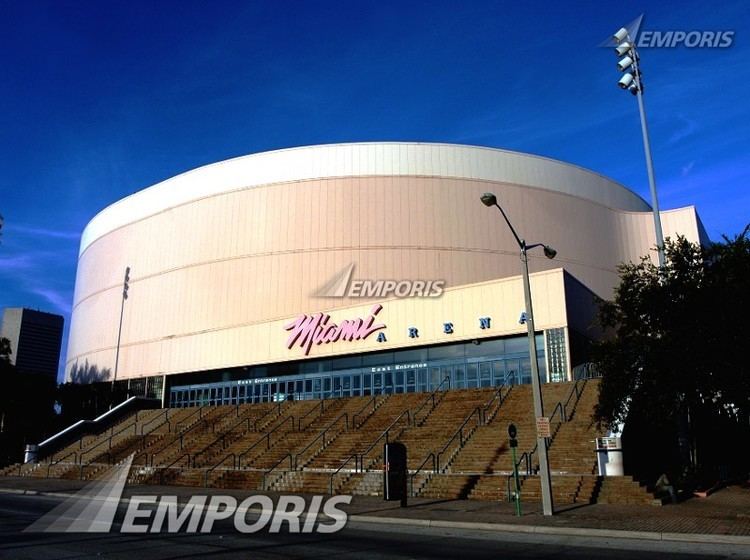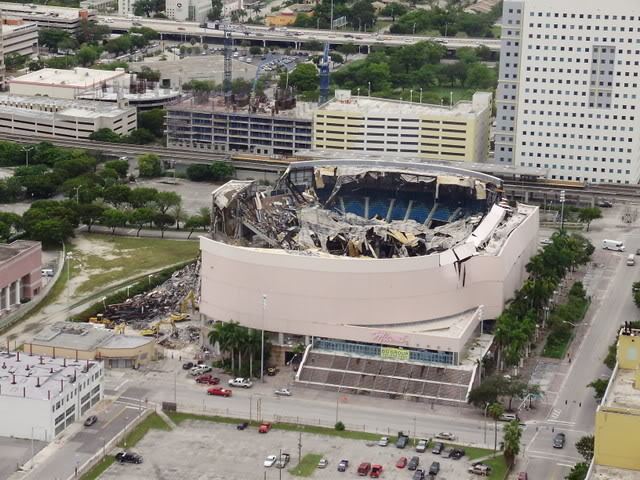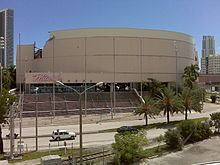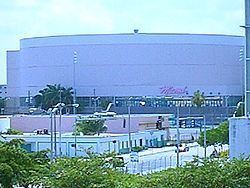Closed July 2008 Capacity 15,200 Architecture firm Populous | Demolished August–October 2008 Opened 13 July 1988 | |
Location 701 Arena BoulevardMiami, Florida 33136 Owner City of Miami (1988–2004)Arena Ventures, LLC. (2004–08) Operator Miami Sports and Entertainment Authority Broke ground August 4, 1986 (1986-08-04) Similar McNichols Sports Arena, Reunion Arena, BB&T Center, American Airlines Arena, Omni Coliseum | ||
History
Completed in 1988 at a cost of $52.5 million, its opening took business away from the Hollywood Sportatorium and eventually led to its demolition. The arena was the home of the Miami Heat from 1988 to 1999, the Florida Panthers from 1993 to 1998, the University of Miami basketball teams from 1988 to 2003, the Miami Hooters of the Arena Football League from 1993 to 1995, the Miami Matadors of the ECHL in 1998, the Miami Manatees of the WHA2 in 2003, and the Miami Morays indoor football from 2005 to 2006. The first game played by the Heat in their first home was a loss to the Los Angeles Clippers, 111-91, on November 5, 1988; the first victory came a month and a half later against the Utah Jazz, 101-80.

The arena also hosted the 1990 NBA All-Star Game, the 1991 WWF Royal Rumble, the 1994 NCAA Men's Basketball East Regional Final, the NHL's 1996 Stanley Cup Finals and the NBA's 1997 NBA Playoffs Eastern Conference Finals between the Miami Heat and Chicago Bulls. The 2001 Christmas Eve episode of WWF Monday Night Raw featuring The Rock was also held here. The WWF had to use the Arena because its normal home since 2000, American Airlines Arena, was hosting the South Florida edition of the Radio City Christmas Spectacular at the time.

By 1998, the Miami Arena, like most indoor sports arenas built in the late 1980s, was beginning to show its age, despite being only 10 years old. Its seating capacity was one of the lowest of any NBA or NHL arena. In addition, sports teams in general began wanting newer, more updated facilities, specifically luxury suites and new concessions. On January 2, 2000, the Heat moved to the new American Airlines Arena located three blocks east of Miami Arena on the shore of Biscayne Bay, as would what is now the WWE. Two years earlier, the Panthers had also left Miami Arena to play at what is now the BB&T Center (originally the National Car Rental Center) located in Sunrise, Florida, near Florida's largest outlet mall, Sawgrass Mills.

Most of the concerts that were held at Miami Arena are now held at newer venues, including the BB&T Center, American Airlines Arena or the Hard Rock Live in Hollywood, Florida.

After the year 2000, the arena became mostly inactive. The arena was sold in a public auction in 2004 to Glenn Straub, an investor from Palm Beach County, Florida, for $24 million less than the $52 million the city of Miami paid for its original construction. Miami Arena was sometimes called the "Pink Elephant", because it was a white elephant with pink colored walls.

The arena was easily accessible via mass transit, with a Metrorail stop at Historic Overtown/Lyric Theater station just across the street (once known as Overtown/Arena station). Miami-Dade city buses also service the arena area downtown.
On August 3, 2008, Straub announced in a television interview that the interior of the arena had been cleared out and that the building would be demolished by the end of the month. On September 21, 2008, the roof of the Miami Arena was imploded. While the exterior walls remained standing after the implosion, demolition continued until the falling of the west wall on October 21, 2008.
Grand Central Park now occupies the site of where the arena once stood.
